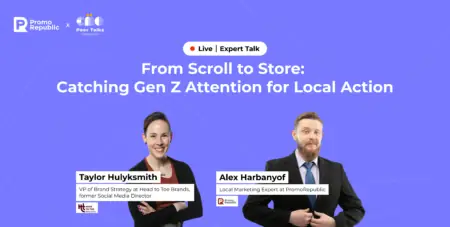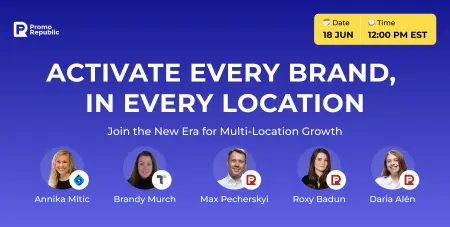Top Local SEO Ranking Factors for Multi-Location Brands in 2025 (And What to Do About Them)
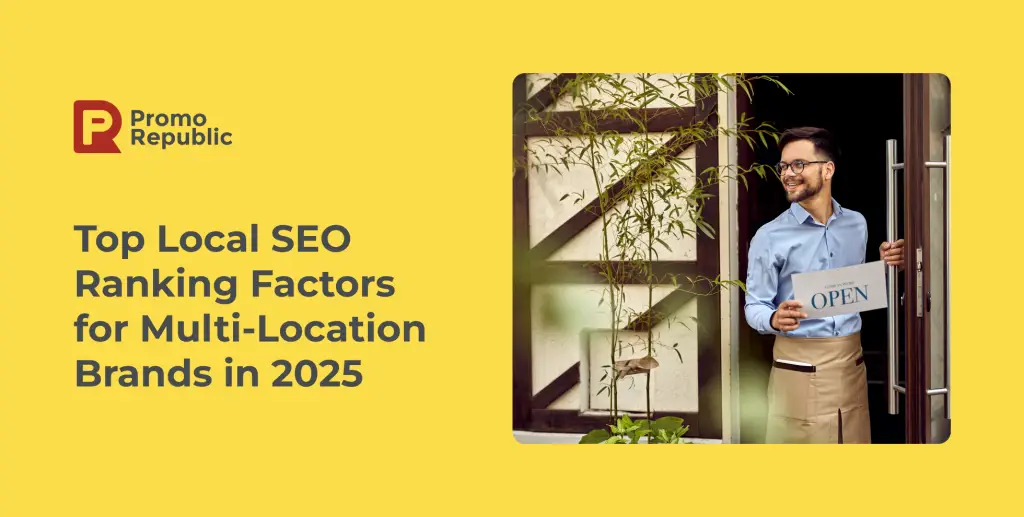
Table of Contents
- What Is Local SEO?
- The 3 Core Local SEO Ranking Factors
- Six Predictable Ranking Factor Trends in 2025
- Tactics To Improve Rankings and Master Local SEO
- Why Local SEO Is Harder When You’re Big
- Final Thoughts
If your brand isn’t showing up in local searches, it’s not getting chosen. That’s the reality multi-location marketing teams face in 2025.
The SEO playbook has been dramatically rewritten in the past year, with AI and quality-focused algorithm updates transforming how local businesses compete for online visibility. Listings now need to be more optimized, content more helpful, and websites more user-friendly.
We’re already seeing brands experience drops in organic traffic where AI Overviews replace traditional results, especially for top-of-funnel queries. That’s why adapting your local SEO strategy now isn’t optional—it’s essential.
In 2025, tricks to cheat search engines won’t work. Instead, brands will need to ensure that they look trustworthy, helpful, and easy to find—for both search engines and real people.
In this post, we’ll unpack the most critical local SEO ranking factors, what’s changed recently, and how brands like yours can take control of their local presence across hundreds—or even thousands—of locations. This is essential reading for anyone doing marketing for franchise brands or managing SEO across multiple locations.
What Is Local SEO?
Today’s customer journey starts and ends with search. Whether someone is looking for a haircut, a dentist, or a same-day courier, their decision-making is shaped by visibility, relevance, and reputation.
Local SEO is how you ensure your locations show up when someone Googles things like:
- “pharmacy near me”
- “best gym in [suburb]”
- “pizza delivery open now”
If your business isn’t being found by the service or product you offer, it likely means your local SEO setup is falling short. And the stakes are high: 28% of those local searches result in a purchase according to Google.
More enterprise brands are now treating local visibility as a conversion asset, not just a branding exercise. This is especially critical in multi-location marketing, where showing up locally equals being chosen.
That means local SEO doesn’t just affect marketing metrics—it impacts:
- Revenue (by driving high-intent, bottom-of-funnel traffic)
- Customer acquisition cost (by lowering dependency on paid ads)
- Operational alignment (by ensuring every location reflects up-to-date info and brand consistency)
If you’re not showing up where customers are searching, you’re giving business away to competitors, often just blocks away.
The 3 Core Local SEO Ranking Factors
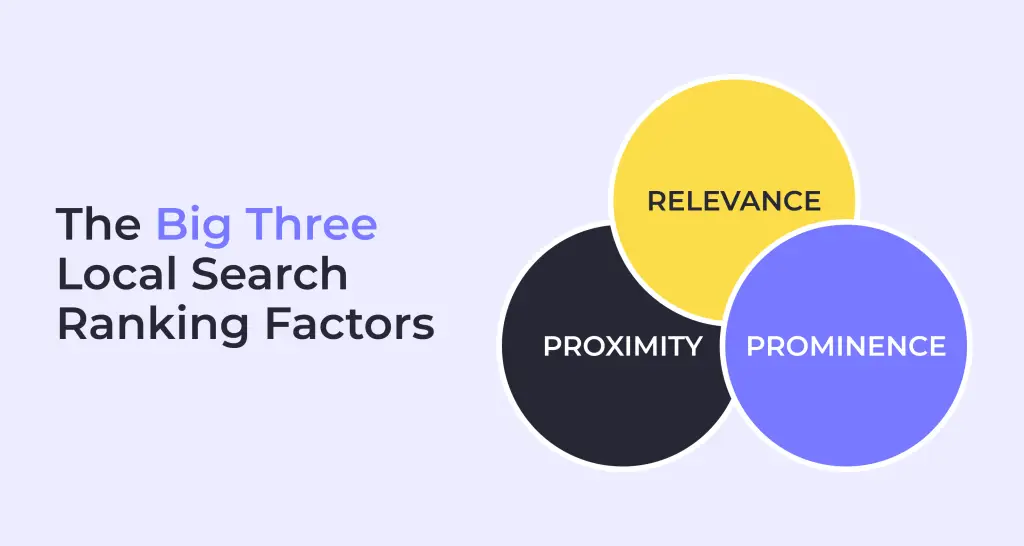
Understanding how local search rankings work is crucial for multi-location businesses, as it helps you optimize your Google listings and other online assets to improve visibility and attract more nearby customers. A big part of this is making sure you know what the top local search ranking factors are.
How exactly Google local ranking factors work is a closely guarded secret, but we have a pretty good idea of what the most important ones are.
There are three main local SEO ranking factors:
- Relevance
- Proximity
- Prominence
Google weighs all of these factors together when determining when, where, and how high to rank local businesses in search results.
Six Predictable Ranking Factor Trends for Local SEO in 2025

Hyperlocal Relevance Beats Generic
Gone are the days of one-size-fits-all local SEO strategies. Google’s algorithms now take a granular approach to local search, rewarding businesses that demonstrate deep, authentic community connections at a hyperlocal level.
How to build hyperlocal relevance at scale:
- Create location pages that include neighborhood-specific FAQs and community info.
- Publish locally tailored social content.
- Encourage franchisees or store managers to post real-time updates tied to events, seasons, or local promotions.
💡Pro tip: Centralizing your SEO strategy while giving locations flexibility to add hyperlocal flavor (via templated content or local post prompts) is the winning combo.
AI-Enhanced Search Intent
AI is fundamentally changing how people search—and how search engines respond.
Today, a typical user journey might look like this:
Ask a question → Get an AI-generated summary → Never click a link.
This shift means fewer website visits, fewer conversions, and declining ROI on generic content.
Even platforms like ChatGPT and Perplexity now surface YouTube videos and source citations directly in results, cutting traditional SEO visibility in half.
What that means for local SEO:
✅ Anticipate the journey, not just the query
Users don’t stop at “best daycare near me.” They keep searching:
about “daycare costs in my area” and “how to enroll in daycare”. Your content should follow that path.
✅ Use structured data, FAQs, and hyperlocal insights
These help AI surface and understand your content more accurately and position it as the best match for user intent.
✅ Use structured data, FAQs, and hyperlocal insights
These help AI surface and understand your content more accurately and position it as the best match for user intent.
✅ Go where AI can’t
To stand out, brands must deliver what AI can’t summarize:
- Original insights
- Authentic local stories
- Clear POVs for niche audiences
Generic content is no longer a strategy—it’s noise.
Ongoing Google Business Profile (GBP) Optimization
Your Google Business Profile (GBP) is no longer just a digital business card—it’s a dynamic, living representation of your brand. To truly make it work for you, it needs ongoing optimization and strategic management to attract engagement and generate leads.
According to Whitespark’s 2024 Local Ranking Factors Survey, GBP signals now account for over 32% of how well a business ranks in Google’s local pack—more than reviews, links, or even on-page content.
And with new features like AI-generated business descriptions rolling out, it’s more important than ever to keep your GBP listing polished, accurate, and up to date.
💡 Pro tip: Optimize your service list to help customers quickly understand what you offer, what it costs, and how to take the next step. Google says this can boost your visibility and drive real business growth.
Reviews as a Critical Ranking Signal
Reviews now make up 16% of local pack and finder rankings, according to Whitespark’s 2024 survey. But here’s the catch: it’s not just about how many you have.
Ben Fisher, Google Product Diamond Expert, shared during CMO Peer Talks session:
“Getting your first 10 reviews can give your rankings a solid lift—Google starts seeing your business as more trustworthy and relevant. Hitting the 100-review milestone? Expect another noticeable boost. But beyond that, piling on more reviews won’t necessarily move the needle.”
What matters more at that stage? Quality, relevance, and recency. Google’s ranking system now prioritizes fresh, well-written, and high-rated reviews that actually help people make decisions.
Key takeaway: Focus on review diversity—across platforms, types, and recency—rather than just accumulating more. This should be a key part of your marketing reporting dashboard.
Mobile-First Indexing
In 2025, mobile optimization is about more than just looking good on a phone—it’s about speed, easy navigation, and content that fits on the go.
Mobile users want fast results, and Google’s mobile-first indexing means mobile sites rank higher. A one-second delay in loading can lower conversions by 20% (Google). Your site must load in under 3 seconds or you risk losing visitors and rankings.
Easy navigation is key. Sticky menus, big buttons, and simple design are expected. Poor navigation leads to more people leaving your site—hurting your rankings.
With mobile-first indexing, your mobile site is what counts most for SEO. If it’s slow or hard to use, your rankings will drop, even if the desktop version is fine. Mobile optimization is no longer optional—it’s a must.
User Experience (UX) Signals
Search engines are now so sophisticated that they can practically feel the user’s journey. Google uses machine learning and artificial intelligence (such as RankBrain, BERT, and MUM) to better understand context, user intent, and behavior patterns.
UX-related metrics like bounce rates, engagement, and interaction quality serve as indirect signals to Google about how users are interacting with a site. This aligns with the broader trend of search engines using behavioral metrics to gauge the quality and relevance of a site, especially for local businesses.
Tactics To Improve Rankings and Master Local SEO in 2025
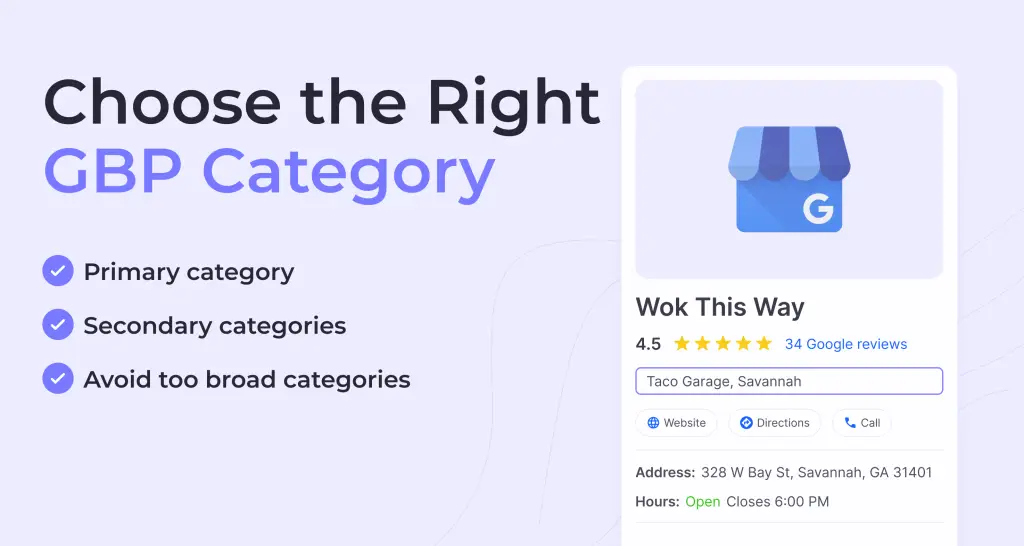
Choose the Right GBP Category
Your Google Business Profile category is not just a small detail; it’s the number one ranking factor for your Google Search and Maps business listing.
Here’s how to nail your GBP category selection:
- Primary category: Select the single most relevant category that precisely describes your core business. This should be the most accurate representation of what you do.
- Secondary categories: Add 2–3 highly relevant secondary categories that reflect additional services or specialties. These help you show up in more specific, intent-driven searches.
- Avoid overly broad categories: Avoid broad or redundant categories. If you’ve already chosen “Chinese restaurant,” you don’t need “restaurant.” Specificity = stronger rankings for qualified searches.
💡Pro tip: Switch categories seasonally. If your services change by season, consider updating your primary category accordingly. hjvb
For example:
- HVAC business → “Air Conditioning Contractor” in summer
- Switch to → “Heating Contractor” in winter
- Lawn care → “Snow Removal Service” during colder months
This dynamic approach keeps your profile aligned with seasonal search intent, and keeps you ahead of the competition.
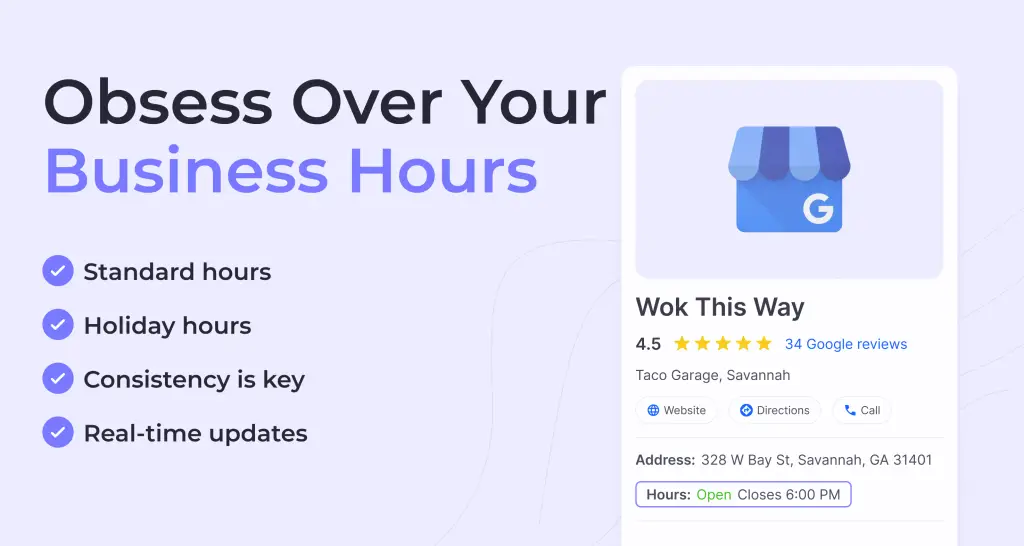
Obsess Over Your Business Hours
Accuracy in business hours might seem trivial, but it’s crucial for local SEO and customer trust. Quick tips to rank (and convert) better in 2025:
- Standard hours: Ensure your regular business hours are 100% accurate across all platforms and locations.
- Holiday hours: Make sure to update special hours for holidays, seasonal changes, or unexpected closures. Customers (and Google) notice.
- Consistency is key: Match your hours across Google Business Profile, your website, social media, and other online directories.
- Real-Time updates: Consider using tools or services that can help you manage and sync your business hours automatically.
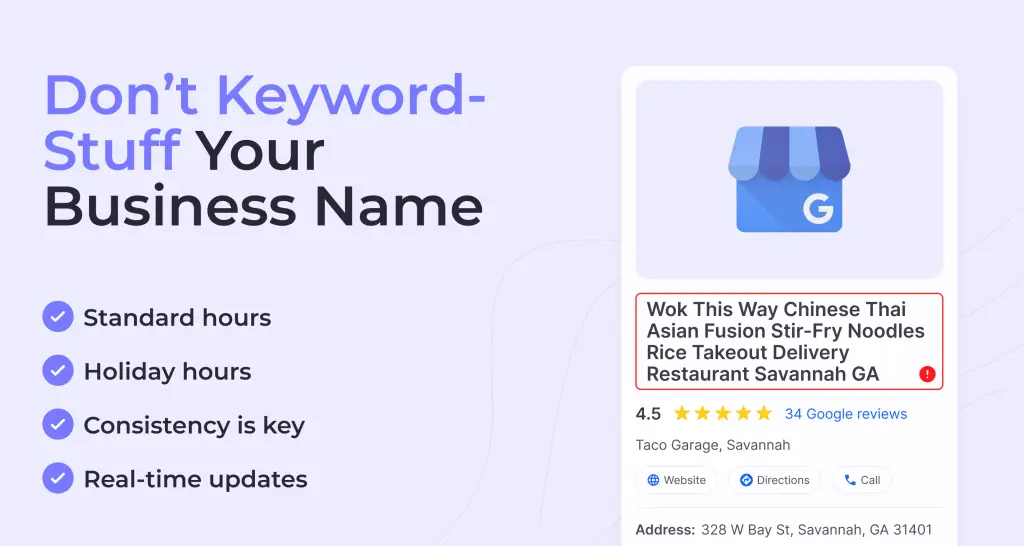
Avoid adding keywords or city names to your GBP name
Your business name or city name won’t help ranking and could lead to suspension. Here’s why:
Google only permits legal business names: Google’s guidelines only allow you to use your registered business name, as it appears on official documents and signage, with no exceptions.
Keyword stuffing=spam: Do not add keywords, service types, or location names to your business name to artificially manipulate rankings, as this violates Google’s anti-spam policies.
Penalties are real: Google actively penalizes businesses that engage in name manipulation, which can result in reduced visibility or profile suspension.
Franchise GBP best practices:
- Use just the brand name—no need to add city names.
- Manage all your locations using GBP labels.
- All locations can (and should) have the same name.
- Got 10 or more locations? Apply for bulk verification to skip video verification when adding new ones.
- If you’re rebranding and removing city names, do it in phases—start with locations that get less traffic.

Strategically Leverage Local Reviews
As we mentioned earlier, reviews are more than just social proof; they’re a significant ranking factor for SEO in 2025, with Google reviews being one of the most important ranking factors for local SEO.
Here’s how to use reviews to your advantage:
- Focus on both quantity and quality: Encourage genuine, detailed reviews from real customers (providing a Google review link can help here).
- Respond to all reviews: Engage with both positive and negative feedback professionally. This can improve engagement signals for your GBP and potentially even turn a negative review into a positive one.
- Collect from other directories: Although Google reviews are the most important, you should also aim to collect reviews across other relevant platforms, such as Yelp, Tripadvisor, and industry-specific directories and review sites.

Create Locally Relevant Content with a Passion
Google wants to show people what actually helps them. If visitors stay, scroll, and click around your page, Google takes that as a thumbs-up and rewards you with better rankings. It’s not about long walls of text anymore. That’s old-school SEO. Short or long, your content just needs to work for your audience.
Here’s what to keep in mind when creating locally relevant content:
- Teach franchisees and teams: Coach your distributed teams the importance of creating hyperlocal content and being proactive on social.
- Write about local events and news: Content that connects to community wins. Local pages on social media and Google posts is where multi-location marketing needs to shine.
- Provide neighborhood-specific information: Share insights, guides, or resources unique to your local area to drive hyperlocal traffic.
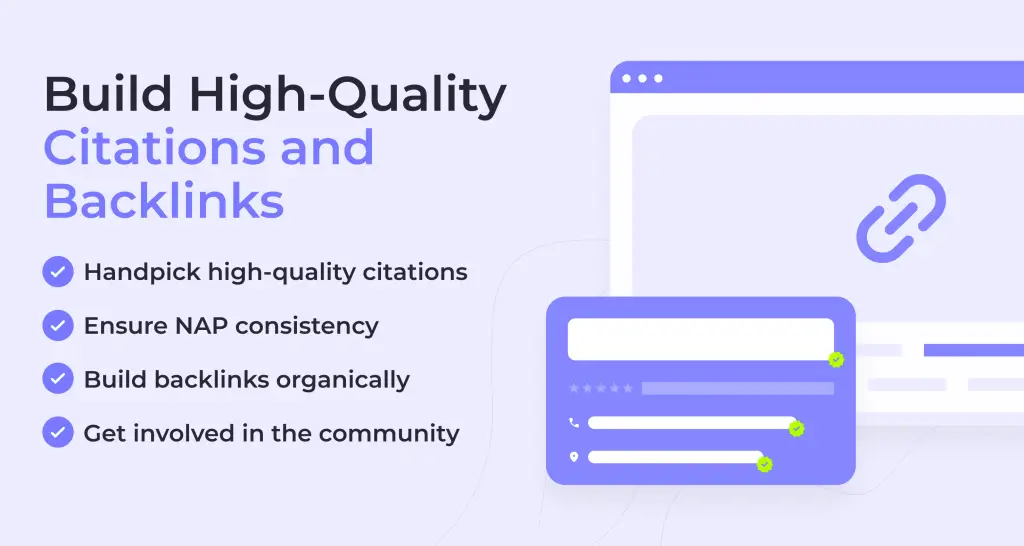
Build High-Quality Citations and Backlinks
Citation and backlink strategies for SEO in 2025 demand a strategic, quality-focused approach. Gone are the days when you could simply spam citations and backlinks to build authority and increase rankings.
Here’s how to do citations right:
- Handpick high-quality citations: Prioritize locally-relevant directories and niche industry listings.
- Ensure NAP consistency: Consistency in Name, Address, and Phone (NAP) information across all platforms is still important.
- Build backlinks organically: Build local content marketing strategies and partnerships that naturally attract high-quality backlinks, rather than purchasing lots of low-quality ones.
- Get involved in the community: Actively participate in community events, local business associations, and chamber of commerce.

Meticulously Create Location Pages
Any multi-location business should have a unique page for each location. All of these pages provide prime opportunities to include localized keywords in content, plus location pages can be used as landing pages for GBP and other directory listings to improve relevance.
Here’s what you need to remember:
- Separate pages for each location: For multi-location businesses, create a unique page for each physical location to improve local search visibility and tailor content to specific areas.
- Optimize with localized keywords: Use keywords relevant to your products, services, and the specific geographic areas you serve naturally within the content.
- Use location pages as GBP landing pages: Link each location’s GBP directly to its corresponding location page on your site to enhance relevance and user experience.
- Include comprehensive, helpful content: Detail offerings with clear descriptions, FAQs, pricing, and other valuable information to improve user engagement.
- Incorporate structured data: Add schema markup for products, services, and locations to help search engines better understand and display your content in local search results.
Why Local SEO Is Harder When You’re Big
Scaling local SEO across 50, 500, or 5,000 locations isn’t about SEO hacks—it’s about systems.
>> Manual updates? Too slow.
>> Individual logins per location? Nightmare.
>> Hoping franchisees follow guidelines? Risky.
At enterprise scale, complexity kills consistency. And consistency is exactly what Google—and your customers—expect across every location.
Disorganized local SEO is costing you more than you think
❌ Outdated business hours and services on GBP
❌ Duplicated or conflicting listings
❌ Missed opportunities to respond to reviews
❌ Disjointed social content that weakens brand credibility
To succeed at scale, you need:
✅ A single source of truth for all location data
✅ Automation to handle repetitive tasks
✅ Brand-approved templates and guidelines
✅ Clear visibility into local performance metrics
You need a marketing tech partner that brings everything together—tools, assets, workflows, and data—in one connected hub. One that uses AI to automate the heavy lifting and empowers franchisees with just the right level of autonomy.
PromoRepublic provides central teams with a data-driven solution: a multi-location marketing platform, AI-powered workflow automation, and a local marketing adoption program. It’s a single, connected system for brand and local execution—delivering visibility, flexibility, and automation at scale.
Joey’s Restaurants drives 121% more visits with PromoRepublic
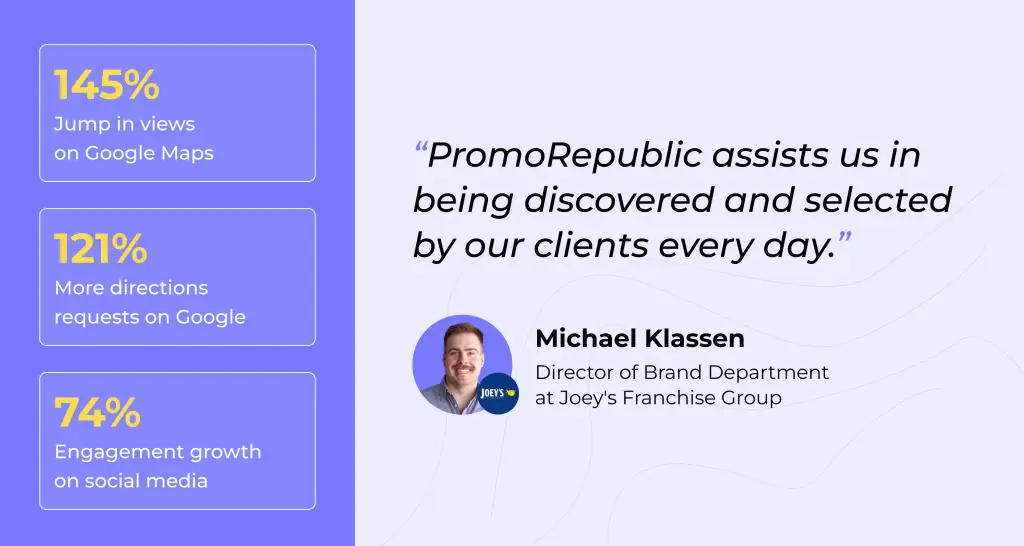
Read the full case study here.
Final Thoughts
Getting found and chosen starts with being visible. The more complete, active, and consistent your profiles are, the better your chances of ranking higher and standing out on Google. Make sure your local teams have the tools to keep business info accurate, content fresh, and reviews flowing—it’s the fastest route to trust and traffic.
For those leading multi-location marketing or doing marketing for franchise brands, the path to being found (and chosen) starts with building trust, relevance, and consistent customer experience—everywhere.
PromoRepublic helps your locations get found by keeping business listings accurate, reviews flowing, and content fresh—everywhere your customers are searching.
You get fresh, real-time data and clear benchmarks to compare results, location by location and against competitors. That means less guesswork and more confidence in your strategy
Want to get a free Local SEO report for your ten locations?

local marketing tips monthly
Enterprise: for multi-location and direct selling brands. Manage thousands of social media pages of your local distributors, partners, or franchisees.
Agency: for marketing agencies. Manage all your clients’ social media pages on one platform.






